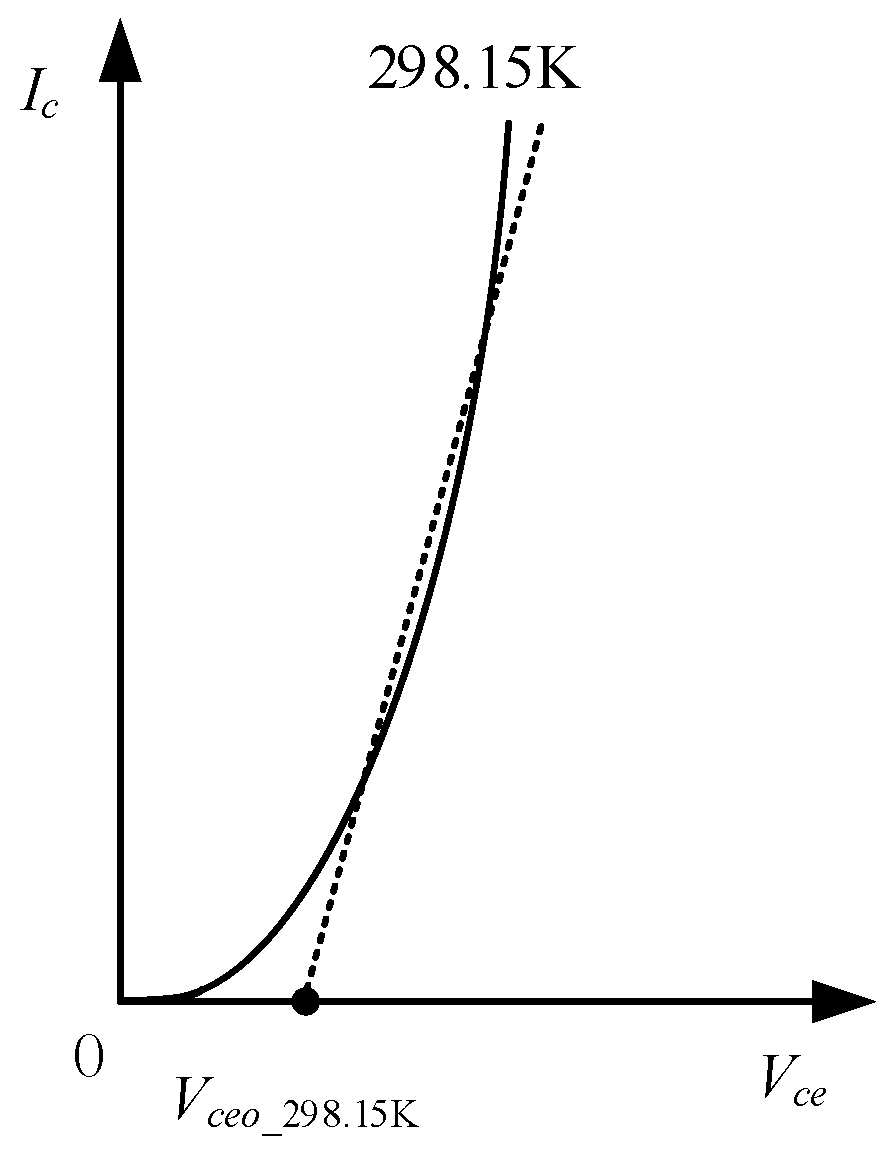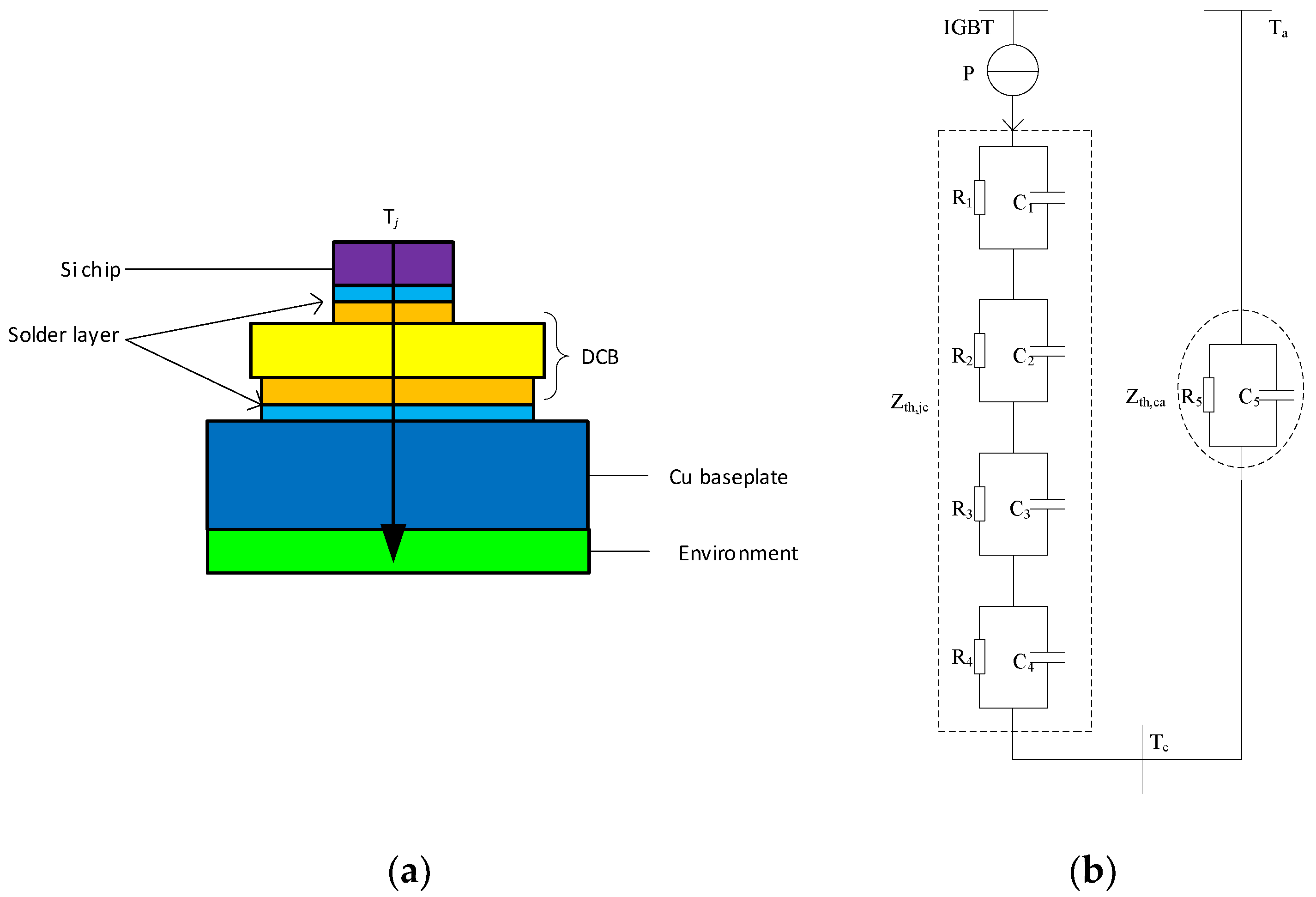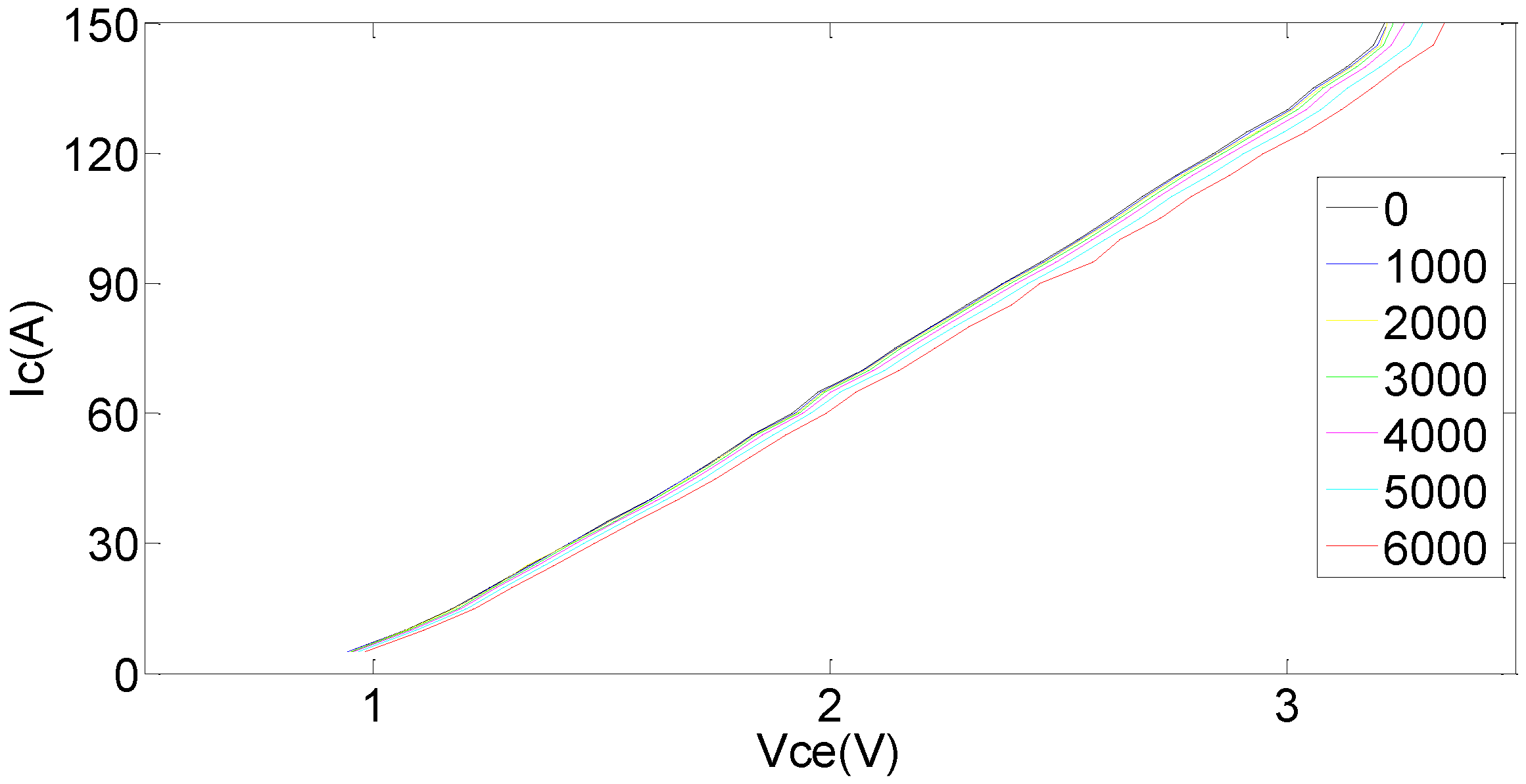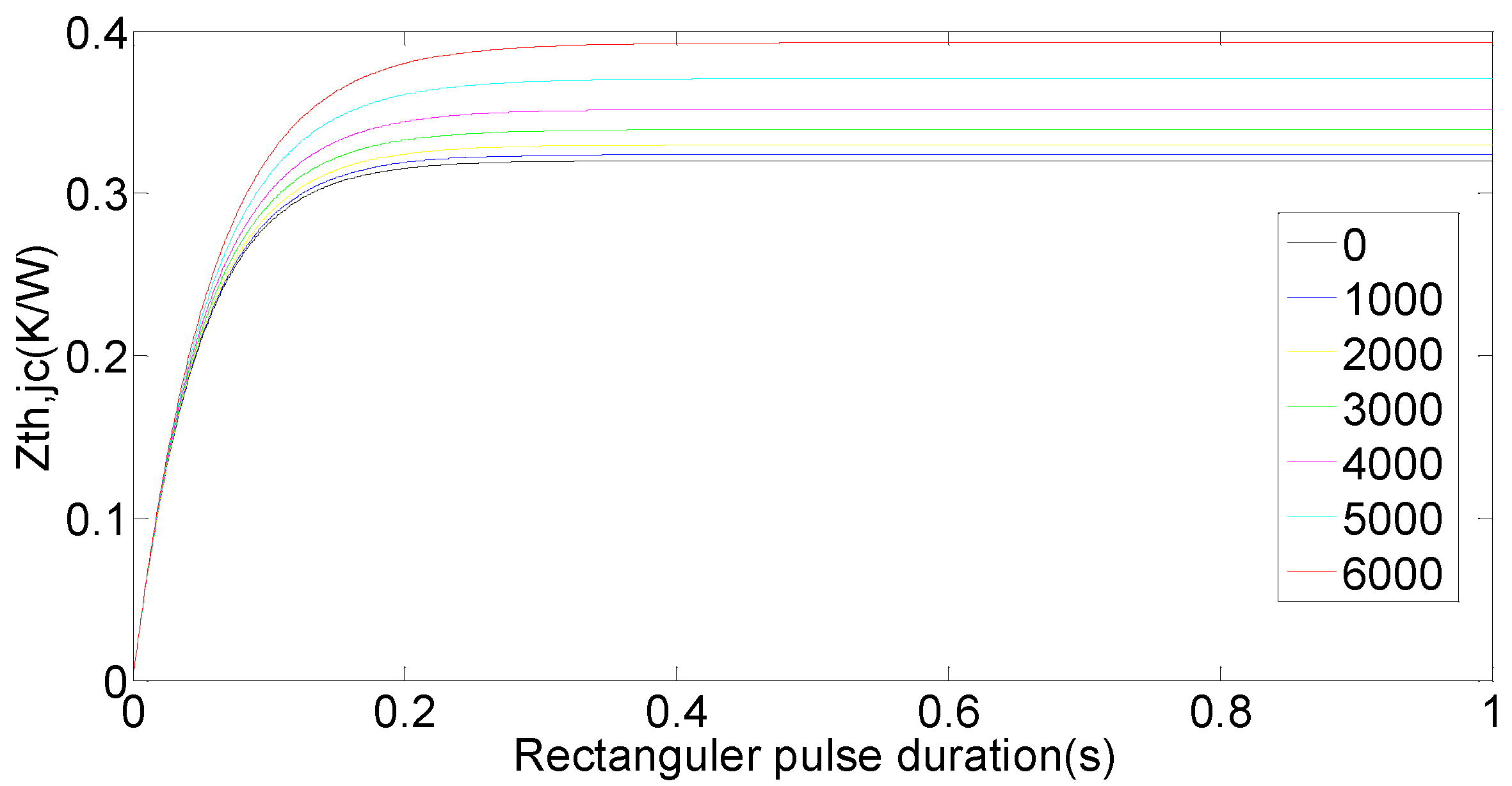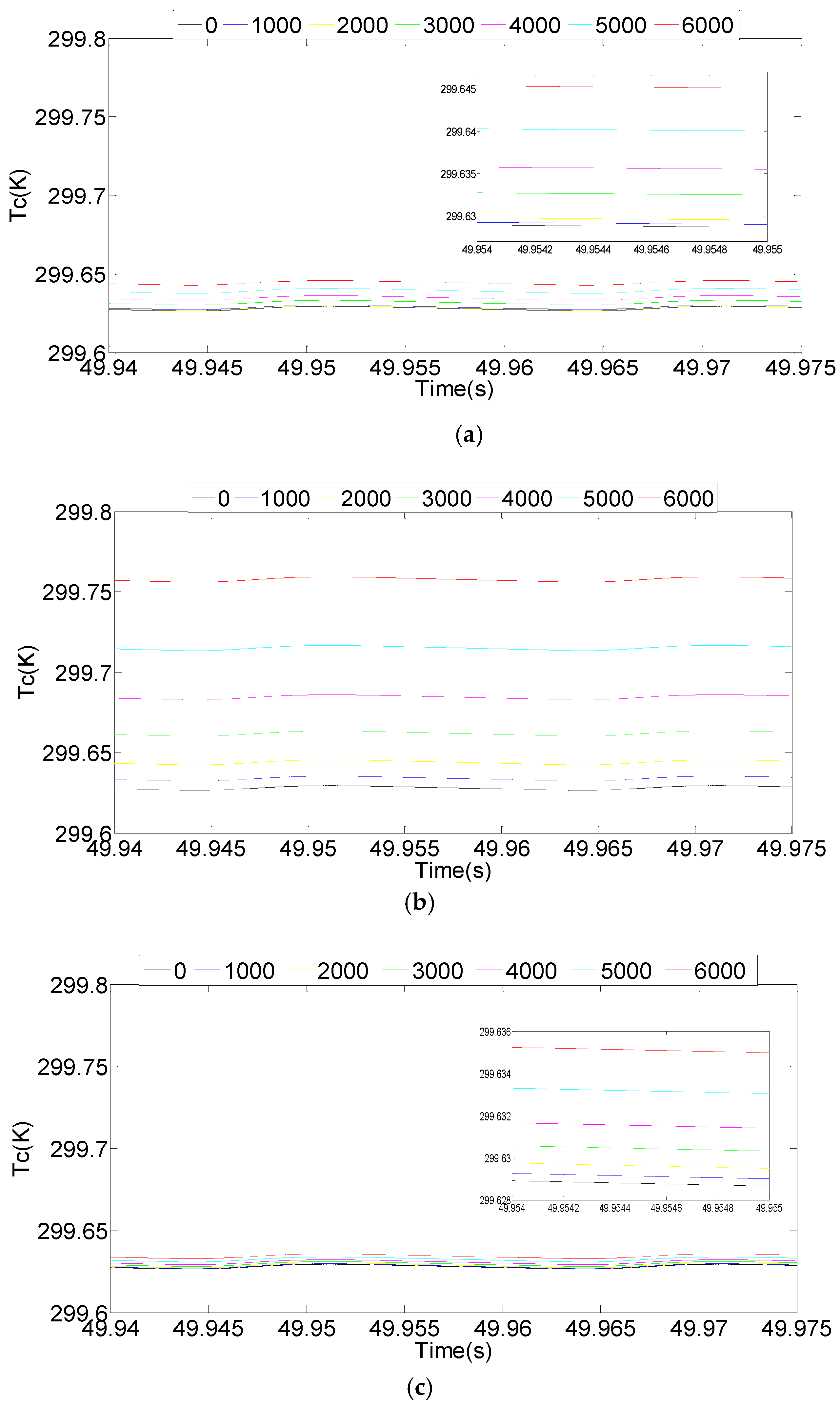1. Introduction
At present, scientists all over the world are striving to explore new energy sources and seeking a path to sustainable development. Constantly expanding the scope of application of new energy is an important means to promote the sustainable development of the entire society [
1]. The core of energy efficient utilization is the efficient control and conversion of various energy forms [
2]. New energy sources such as wind energy are being widely used in the field of electrical energy conversion, where wind turbines often work in harsh environments and are easily affected by the performance of their subsystems. As the most important subsystem, the power conversion device causes the wind turbine to stop working in case of failure [
3]. The Insulated Gate Bipolar Transistor (IGBT) power module is the most important device in the power electronics subsystem, whose working ability gradually decreases with as it ages under practical working conditions [
4]. Therefore, how to accurately evaluate the aging state of the IGBT power module to ensure the stable operation of the wind turbines is an important study topic [
5,
6].
In the literature, Bo et al. [
7] found that the failures of IGBT power module are mainly caused by thermal mechanical stress caused by temperature fluctuations, and the reliability of the power module is closely related to the junction temperature. In the assessment of the aging state of IGBT, the aging state of the power module is often evaluated by monitoring the changes of certain parameters, which include the saturation voltage drop, junction-to-case thermal resistance, switching time, gate signal, and junction temperature [
8]. Ji et al. [
9] proposed a method to reflect bonding wire failure by monitoring the change of saturation voltage drop, which is one of the most common package failures. However, the saturation voltage drop varies with the aging of the IGBT until the failure of IGBT, and while this method can monitor the failure of the IGBT, it cannot fully monitor the aging state of the IGBT power module. Oukaour et al. [
10] studied the change law of IGBT saturation voltage drop with module aging through power thermal cycling tests, but they did not consider the influence of junction temperature and collector current variation on the saturation voltage drop, therefore, the error between the evaluated aging state and the actual aging state was large.
In the practical application of IGBT power modules, IGBTs fail when they work for a long time, and the fault reasons mainly include the bonding wires falling off and solder layer fatigue, and these faults are caused by the aging of the IGBT power module [
11]. The aging state of the power module is mainly evaluated by using electrical parameters and thermal parameters [
12]. For example, the IGBT saturation voltage drop is commonly used to evaluate the case of bonding wires falling off [
13]. The junction-to-case thermal resistance is often used to evaluate the state of the solder layer fatigue [
14]. Whether the saturation voltage drop or the junction-to-case thermal resistance is used to evaluate the aging state of the IGBT power module, the junction temperature will be used. The commonly used methods of junction temperature measurement and calculation include experimental measurement [
15], iterations and numerical simulation, and simulation analysis [
16]. The proposed methods neither achieve accurate online measurements nor do they consider the influence of different degrees of aging of the IGBT power module on junction temperature.
This study proposes a simple and convenient to use the case temperature to evaluate the aging state of the IGBT compared to the measurement of electrical parameters. Wang et al. [
17] used the Cauer thermal network model to monitor the temperature change, but it is difficult to obtain the parameters of the model. Astigarrag et al. [
18] performed power thermal cycling tests on different types of parameter and showed that the case temperature, the collector current and the collector-to-emitter voltage can all be used as failure precursors for prediction and health monitoring. Hence, this study considers the case temperature as the precursor of the fault, which does not take account of the influence of the parameters, such as the collector-to-emitter voltage on the case temperature, so the prediction results have a certain error.
The prior proposed methods do not fully consider all the influencing factors by using the on-state voltage drop or monitoring the junction temperature and the case temperature to evaluate the aging state. With the aging of the power module, the structure of the power module and the electro-thermal parameters of the junction temperature calculation model are constantly changing, therefore, this is necessary to study the influence of the electro-thermal parameters on the junction temperature under different aging states. This study not only analyzes the influence of switching loss and thermal impedance of IGBT on the junction temperature and the case temperature, but also analyzes the influence of threshold voltage and on-resistance of IGBT on the junction temperature and the case temperature. This study makes the simplification of the junction temperature calculation model more theoretically significant, at the same time; the case temperature can more intuitively reflect the changes of the electro-thermal parameters.
This study has the following goals: (1) Using the principle of electro-thermal analogy, combing the electrical model with the Foster thermal network model to establish an electro-thermal coupling model to calculate the junction temperature and the case temperature of the IGBT. (2) Analyzing and comparing the influence of different electro-thermal parameters on the junction temperature and case temperature, which can simplify the junction temperature calculation model and provide a new idea for further studying the relationship between case temperature and switching loss of IGBT. The rest of this study is organized as follows:
Section 2 describes the process of the electro-thermal coupling model.
Section 3 describes the test process.
Section 4 analyzes the test results, the junction temperature and the case temperature under different aging state are calculated, and the degrees of influence of different electro-thermal parameters on the junction temperature and case temperature is calculated.
Section 5 summarizes the implications of this study with spotlights on the research significance and popularization of this research. Finally,
Section 6 discusses the conclusion.
4. Results Analysis
The single parameter method is used to study the influence of electro-thermal parameters on junction temperature and case temperature. Namely, by changing the above parameters of the IGBT at different power cycle times, the junction temperature and case temperature are calculated. The results obtained are shown in
Figure 9 and
Figure 10.
Comparing the subfigures (a), (b) and (c) in
Figure 9, the threshold voltage and on-resistance have the least effect on the junction temperature, the switching loss has a larger effect on the junction temperature, and the thermal impedance has the largest effect on the junction temperature. Comparing subfigures (a), (b) and (c) in
Figure 10, the thermal impedance has the least effect on case temperature, and the threshold voltage and on-resistance have small effect on case temperature, and the switching loss has the greatest effect on case temperature. The thermal impedance can directly reflect the fatigue degree of the solder layer, which has the greatest effect on the junction temperature and has the least effect on the case temperature.
The mean value of temperature fluctuation is taken as the reference value for analyzing the influence degree of electro-thermal parameters on the junction temperature and case temperature. The mean value of the junction temperature and case temperature under different aging states are expressed as
and
. The subscript numbers indicate the numbers of thousand cycles, all of them are shown in
Table 6 and
Table 7. The influence degrees are defined to express more intuitively the influence degree of the electro-thermal parameters on the junction temperature and case temperature:
where,
is the influence degree on the junction temperature with the change of of
and
,
is the value of the junction temperature with the change of
and
at different aging states:
where,
CcVr is the influence degree on the case temperature with the change of
Vceo and
rce,
TcmiVr is the value of the case temperature with the change of
Vceo and
rce at different aging states.
The influence degree of changing Eon and Eoff on junction temperature and case temperature, and the influence degree of changing Zth,jc on junction temperature and case temperature is obtained.
Table 6 and
Table 7 show that different electro-thermal parameters have different degrees of influence on the junction temperature and case temperature of the IGBT power module. Taking the degree of influence on the junction temperature with the change of electro-thermal parameters as a reference, changing the thermal impedance the thermal impedance
Zth,jc alone has the greatest influence on the junction temperature, and the degree of influence is C = 60.1%. Taking the degree of influence on the case temperature with the change of electro-thermal parameters as a reference, changing the switching losses
Eon and
Eoff have the greatest influence on the case temperature, and the influence degree is C = 79.8%. It can be considered that the main causes of the change in junction temperature is the parameter change of thermal impedance
Zth,jc. This study considered that the main reason of the change in case temperature is the change of switching losses
Eon and
Eoff.
5. Implications
Traditional assessment models were used to evaluate the aging state of the power model in previous studies, which were evaluated using electrical or thermal parameters. Compared with previous studies, this study has two major contributions: (1) In this study is difficult to evaluate the whole aging state of the IGBT module by using the saturation voltage drop or the junction-to-case thermal resistance alone, and the above parameters are related to the junction temperature Tj, but the measurement of the junction temperature is difficult. This study analyzes the influence of the electro-thermal parameters on the junction temperature under different aging states, and provides data support for simplifying the junction temperature calculation model. This result improves the existing junction temperature calculation model and improves its prediction accuracy. (2) The influence of electro-thermal parameters on case temperature is analyzed. This lays a theoretical foundation for evaluating the aging states by using the case temperature and finding the relationship between case temperature and electro-thermal parameters. The case temperature can reflect the aging state of the IGBT, and the results provide a new way to establish the relationship between junction temperature and case temperature.
The failure of power modules is the main cause of power converter failure in wind turbines. The model established can simultaneously study the junction temperature and case temperature of the power modules, and the influence degree of different electro-thermal parameters on junction temperature and case temperature can be obtained. The junction temperature calculation and the aging states assessment are always solved to use the established model and analysis method in this study. The results are helpful to quickly find the cause of IGBT failure, which is beneficial to the reliable operation, and has a positive effect on the stability of power system and the effective use of new energy sources. The analysis method can be applied in other fields too. For example, in the field of fault diagnosis of power transformers, the influence of different parameters on power transformer faults can be analyzed according to the single parameter method, which is helpful to quickly find the cause of the power transformer failure. In the life prediction of relays, analyzing the influence of different parameters on the life of the relay is beneficial to remove redundant parameters and improve the accuracy of life predictions. Therefore, the results are of great significance for equipment transformation and industrial upgrading.

